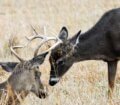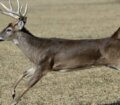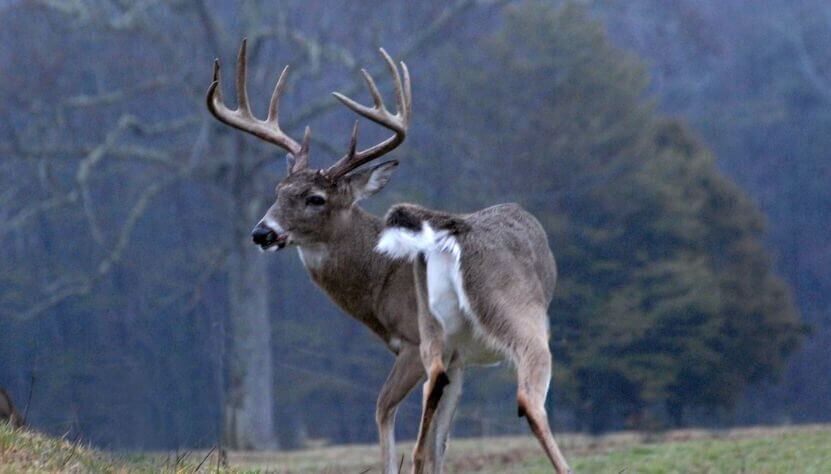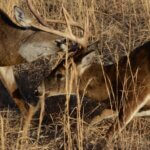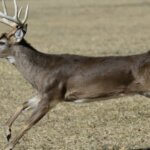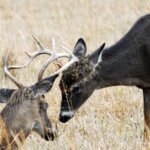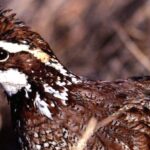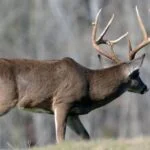Editor’s Note: Bucks fight for several reasons. When you hear antlers clashing, that doesn’t necessarily mean that bucks are fighting to the death. Instead, the bucks only may be pushing each other around. The more you know about buck fights, the better you’ll understand when to go and when to stay when you hear antlers clashing.
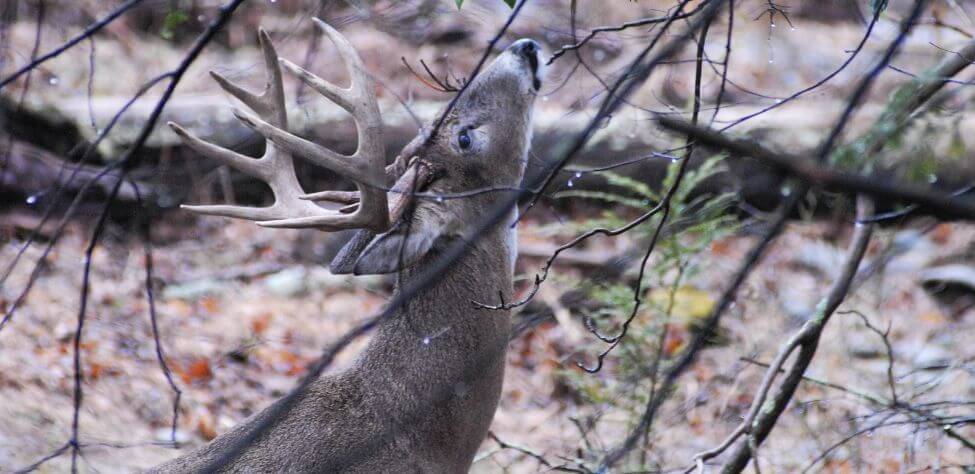
Terry Rohm:
This longtime deer hunter and well-known outdoorsman from Georgia says, “When a doe comes into heat, she’ll only stand to be bred for a little more than 24 hours. During that time, the bucks that want to breed her often will be in conflict. The most-intense fighting occurs during the breeding season. Since does only come into heat for about 28 hours, all the bucks in an area will be fighting over that one particular estrous doe, and they’ll be extremely aggressive.”
Charles DeYoung:
Charles DeYoung, a researcher at Texas A&M University, mentions that, “The males will have arranged themselves in a dominant hierarchy in the summertime and early fall before the rut, which is when they become very aggressive. By the time the breeding season starts, each buck recognizes how he fits into the pecking order and doesn’t have to fight to establish relationships with the other bucks. However, the most-vicious fights happen between two, equally-matched bucks that don’t know each other and haven’t had the opportunity to work out their dominance relationships with one another.”
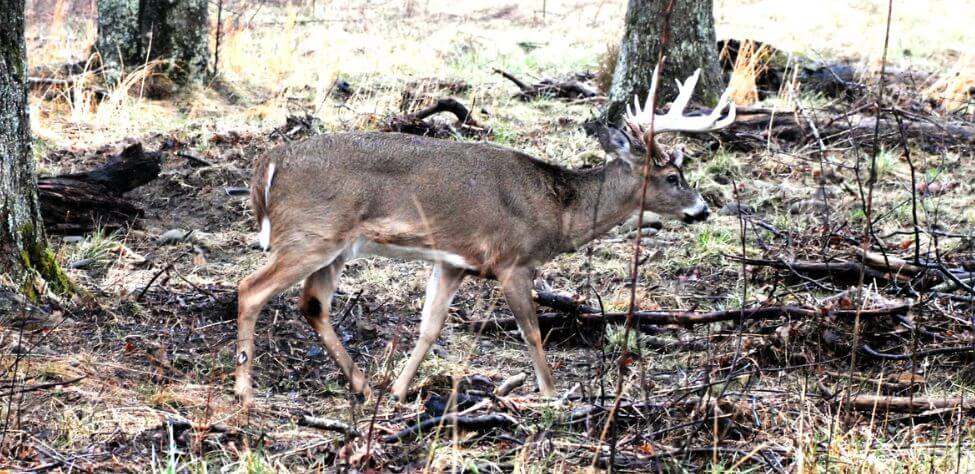
This situation often occurs when bucks expand their home ranges during the rut. A dominant buck may move into another buck’s home range, while following an estrous doe. Current research tends to indicate that when a doe is in estrus, she often makes a journey outside her home range to find a buck to breed, which may be nature’s way of preventing inbreeding. But when she leaves her home range, the dominant buck in that region may follow her. Then when she encounters the dominant buck of another area, the two bucks will have to face-off with each other. Sometimes a fight may develop.
Dr. Larry Marchinton:
According to Dr. Larry Marchinton, retired professor of wildlife biology at the University of Georgia’s School of Forest Resources and well-known deer researcher, “There is such a thing as super-dominance. A buck may be dominant anywhere he goes, if that buck is head-and-shoulders bigger and stronger than any buck in the entire area. Also, some dominant bucks may not be clearly superior over each other. If a doe is in heat, and both bucks are present, they may have a dominance fight to settle which is strongest and can claim the right to breed.”
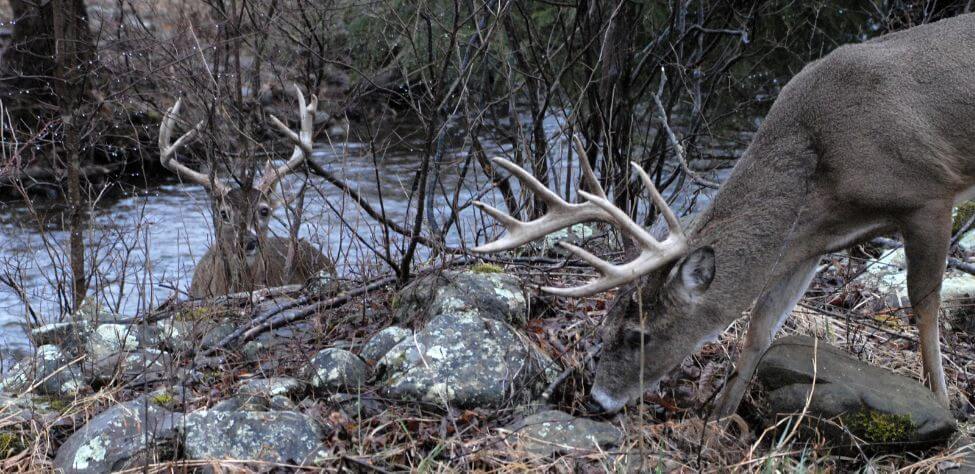
Even the skinniest guy on the beach will challenge the most-musclebound bully when a woman and sex are involved. Deer will exhibit similar behavior. When the breeding season occurs, even bucks on the lower end of the pecking order may challenge the dominant buck for the right to breed an estrous doe.
Bob Zaiglin:
According to Bob Zaiglin, longtime Texas wildlife biologist, “Although very-few small bucks try to fight older bucks, this situation can happen. Older bucks have more of a tendency to fight other older bucks, and these bucks are more likely to really hurt each other.”
However, some younger or subordinate bucks don’t fight fairly in their eagerness to fight. A younger buck may run in and gore an older buck that’s locked in combat with another mature buck.
Dr. Harry Jacobson:
Dr. Jacobson, a well-known deer research at Mississippi State University, explains that, “During the rut, bucks aren’t sparring but are actually fighting with the intent of doing-in their rival and breeding a doe,” Jacobson explains. “The bucks seem to form an aggressive territory surrounding a doe in estrus. This aggressive territory is the distance from the doe that no other buck can come into without encountering antlered resistance.
“Sometimes bucks fight to the death but usually not. What wildlife scientists see more frequently is two bucks fighting, and a third, usually a subordinate buck, coming in and doing in one of the two in combat, while the two bigger bucks are antler to antler. Although this subordinate buck sees his chance to get into battle, as soon as the older buck squares off on him, he will run. Probably this is why rattling works. When two bucks are fighting, a subordinate buck realizes a doe in estrus is somewhere around, and he can get a quick lick in on one of the two dominant bucks while they are locked in combat.”
Tomorrow: Deer Death Fights and Rattling Antlers

How to Hunt and Take Big Buck Deer on Small Properties
In this book, you’ll hear from 14 hunters who either have gained permission or leased properties as small as six acres to as much as 250 acres, and how they consistently take older-age-class bucks off these little lands.
VERSIONS: AUDIBLE, KINDLE & PRINT

Jim Crumley’s Secrets of Bowhunting Deer
Using a black magic marker and a gray work jumpsuit, Jim Crumley of Buchanan, Virginia, drastically changed the nature and purpose of hunting camouflage when he created the first sportsman’s camouflage – Trebark. Crumley’s love of bowhunting and his desire to be more invisible changed hunting clothing forever.
In this hunting guide, he shares the wisdom that he’s learned throughout his lifetime about how to be a hunter, how to find a deer lease, how to scout for deer, and more.
Special features include how to:
- Have a magic 60 acres to hunt
- Decide the best equipment to use
- Find deer year-round
- Locate land to hunt
- Know the best place to put your tree stand
- Get bucks within bow range
VERSIONS: AUDIBLE, KINDLE & PRINT

How to Hunt Deer Like a Pro
How do you know if the land you hunt has a trophy deer on it? Wildlife manager Bob Zaiglin, of Uvalde, Texas and Jim Crumley, the father of modern-day hunting camouflage, tells you how to find out. GPS can make finding and taking that trophy buck easier. This hunting guide will teach you how to hunt big bucks where no one else can find them, how to call deer, and how to become versatile as a deer hunter, so that if one deer tactic doesn’t work, another one will.
In the chapter, “How to find Bucks at Scrape,” Dr. Keith Causey, retired professor of Wildlife Science at Auburn University, describes the best way to hunt a scrape.
Brad Harrison of Neosho, Missouri, is a nationally-known videographer, professional deer hunter and master at calling deer. Another master is Will Primos of Primos Game Calls. These two experts will tell the best deer calls and when to use them in this book.
And for over 20 years, Bo Pitman, lodge manager of White Oak Plantation, has been studying deer movement patterns. He explains what types of conditions are best for predicting deer movement.
VERSIONS: AUDIBLE, KINDLE & PRINT

Deer hunting and deer hunters are drastically changing each year. To learn new techniques for hunting deer and have more places to hunt, I’ve interviewed some of the best deer hunters in the nation and share their tactics in How to Hunt Deer Like a Pro: Volume II.
In Chapter 10, Jacob Lamar tells you his tactics for consistently taking older-age-class bucks on public lands in several states. Chapter 11, Bob Walker explains how to find places on public lands where you can hunt that 99 percent of the other hunters never have considered hunting. The Bonus Chapter with David Ramey tells you how, where, when and with what equipment to take big Kansas bucks on public lands by hunting in 100-degree weather when others won’t hunt.
Chapter 13, Mark Drury, his family and his guests take mature bucks every season by having more small places to hunt rather than one large property. Drury explains the strategy of having satellite farms to hunt that only may be 50-150 acres each or less. Chapter 15, Pat Reeve, who hunts far-northern states and Canada, says, “I don’t like hunting for mature bucks until the weather is 20 degrees or less.” Chapter 4, Dr. Larry Marchinton says that funnels are the most-reliable stand sites to hunt for big bucks and tells why.
VERSIONS: AUDIBLE & PRINT

